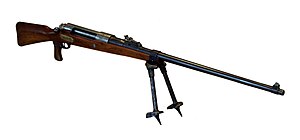Our website is made possible by displaying online advertisements to our visitors.
Please consider supporting us by disabling your ad blocker.
Mauser Tankgewehr M1918
| Mauser Mod. 1918 13.2 mm Tankgewehr | |
|---|---|
 13.2 mm Rifle Anti-Tank at the Musée de l'Armée in Paris | |
| Type | Anti-tank rifle Anti-materiel rifle |
| Place of origin | German Empire |
| Service history | |
| In service | 1918–1933 |
| Used by | |
| Wars | |
| Production history | |
| Manufacturer | Mauser |
| Produced | January 1918 – April 1919 |
| No. built | 16,900 |
| Variants | M1918 shortened Magazine-fed[1] |
| Specifications | |
| Mass | 15.9 kg (35 lb), 18.5 kg (41 lb) loaded with the bipod |
| Length | 169.1 cm (5 ft 7 in) |
| Barrel length | 98.4 cm (3 ft 2.7 in) |
| Crew | two-man crew |
| Cartridge | 13.2 mm TuF (German: Tank und Flieger) |
| Caliber | 13.2 mm (.525 inches) |
| Action | bolt-action |
| Rate of fire | single-shot |
| Muzzle velocity | 780 m/s (2,600 ft/s) |
| Effective firing range | 500 m (550 yd) |
| Feed system | manual |
| Sights | 100–500 m (110–550 yd) (notched V) |
The Tankgewehr M1918 (transl. Tankgun), also known as the Mauser 13mm anti-tank rifle and T-Gewehr in English,[2][3] is a German anti-tank rifle[4]—the first rifle designed for the sole purpose of destroying armored targets—and the only anti-tank rifle to see service in World War I. Approximately 16,900 were produced.
- ^ Robert Ball (2011). Mauser Military Rifles of the World, 5th Edition. Gun Digest Books. p. 193. ISBN 978-1-4402-1544-5.
- ^ Ball, Robert M. (2006). Mauser Military Rifles of the World (Mauser Military Rifles of the World). Gun Digest Books. p. 183. ISBN 978-0-89689-296-5.
- ^ Stephen Bull (2004). Encyclopedia of military technology and innovation. Greenwood Publishing Group. p. 15. ISBN 978-1-57356-557-8.
- ^ "WW1 Anti-Tank rifles" (Microsoft FrontPage 6.0). Retrieved 10 October 2014.
Previous Page Next Page


